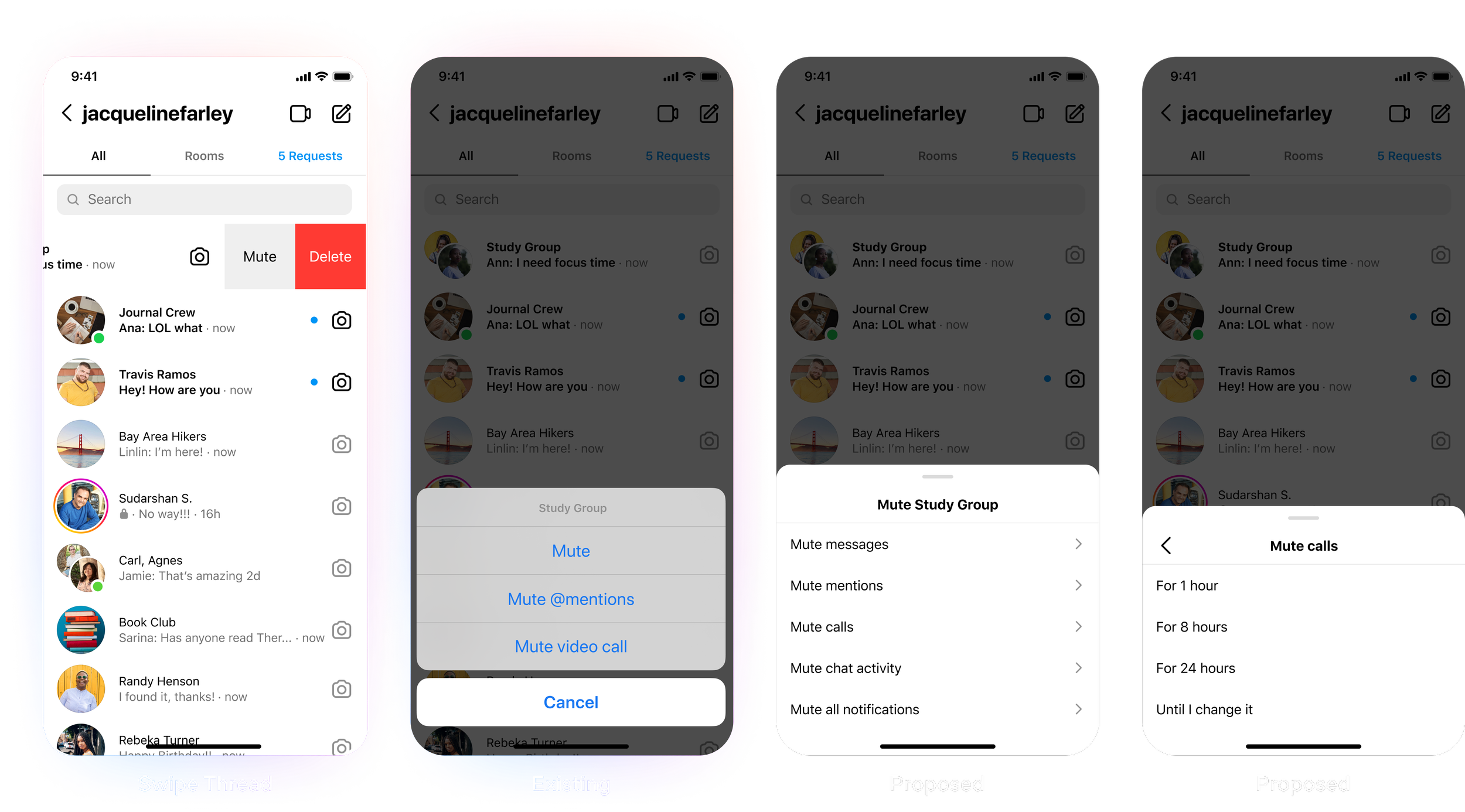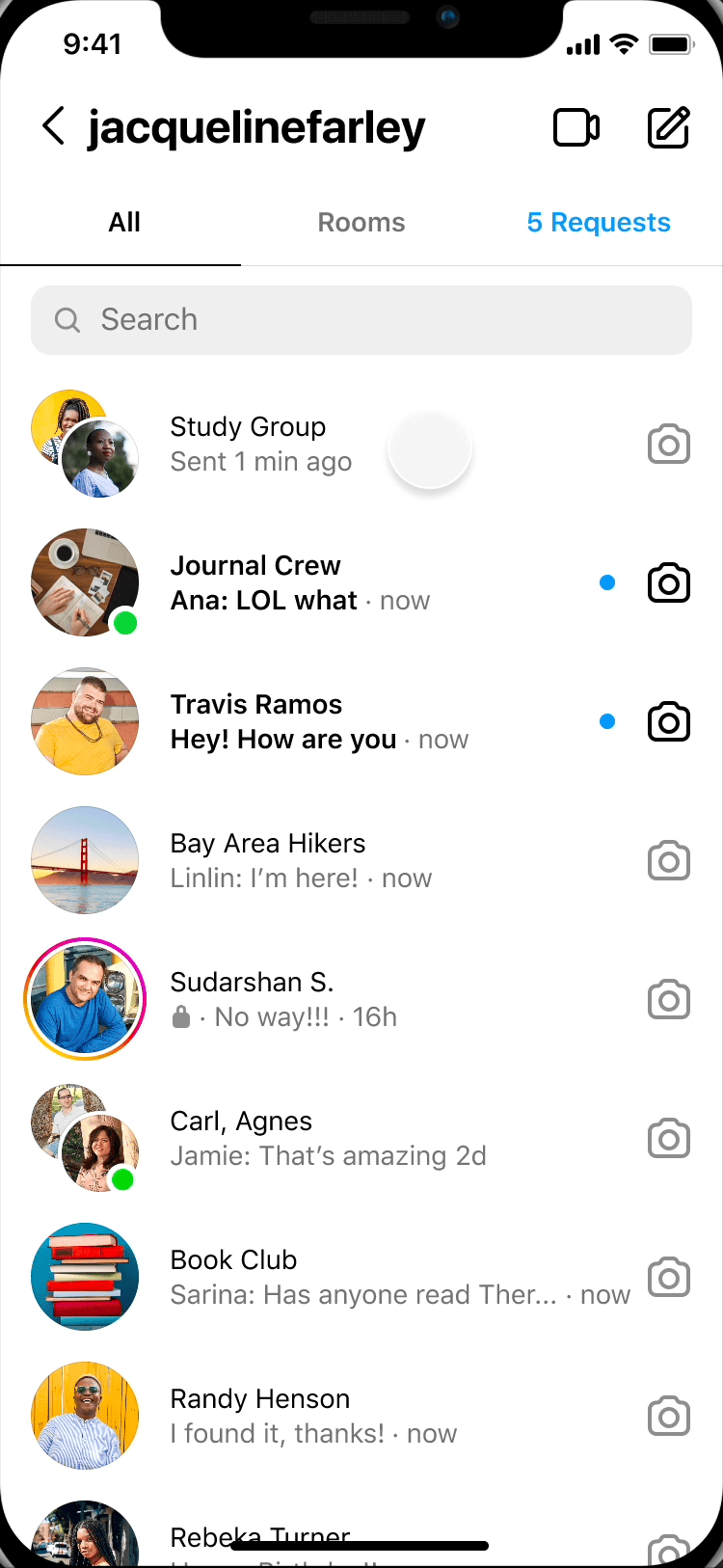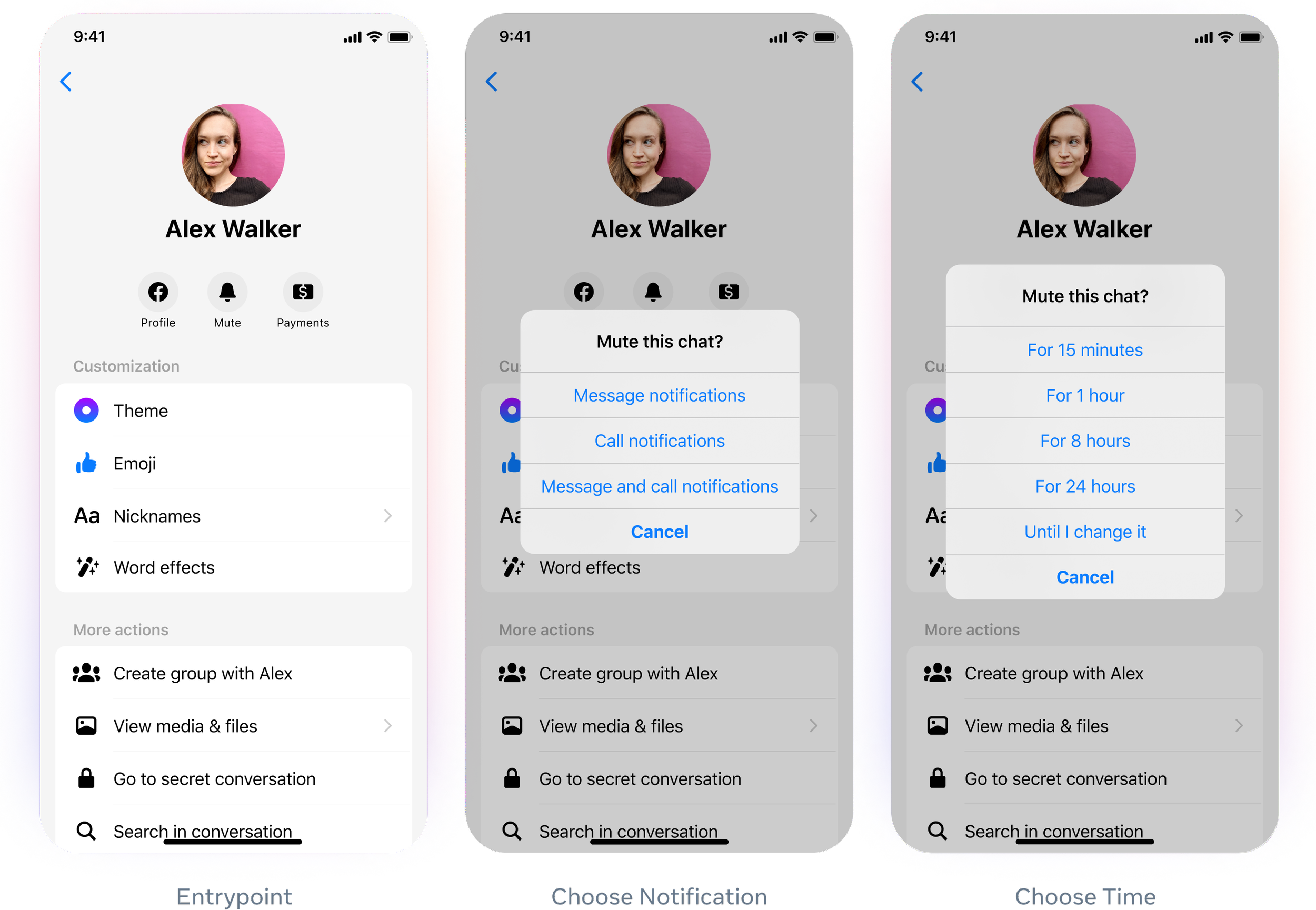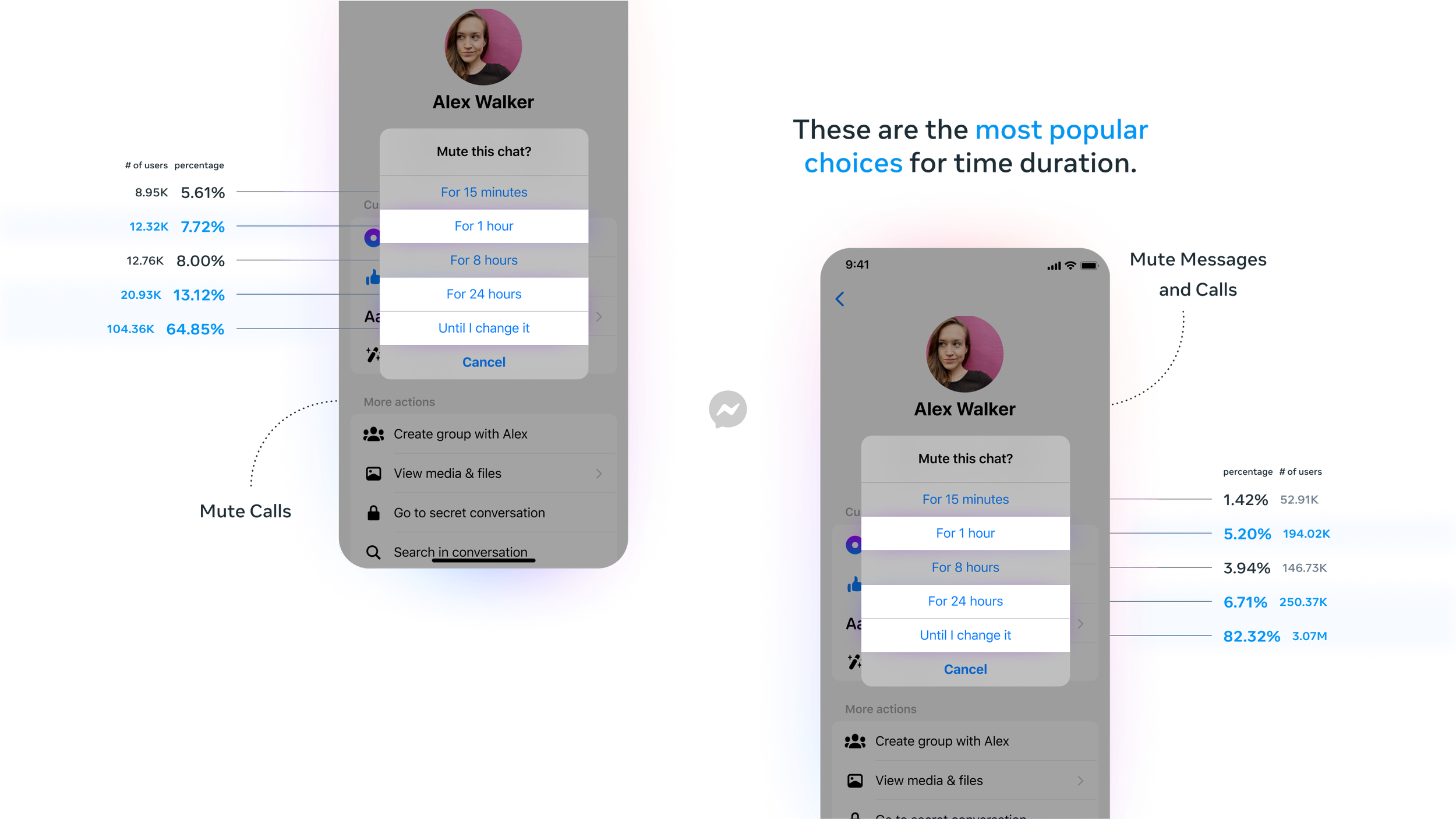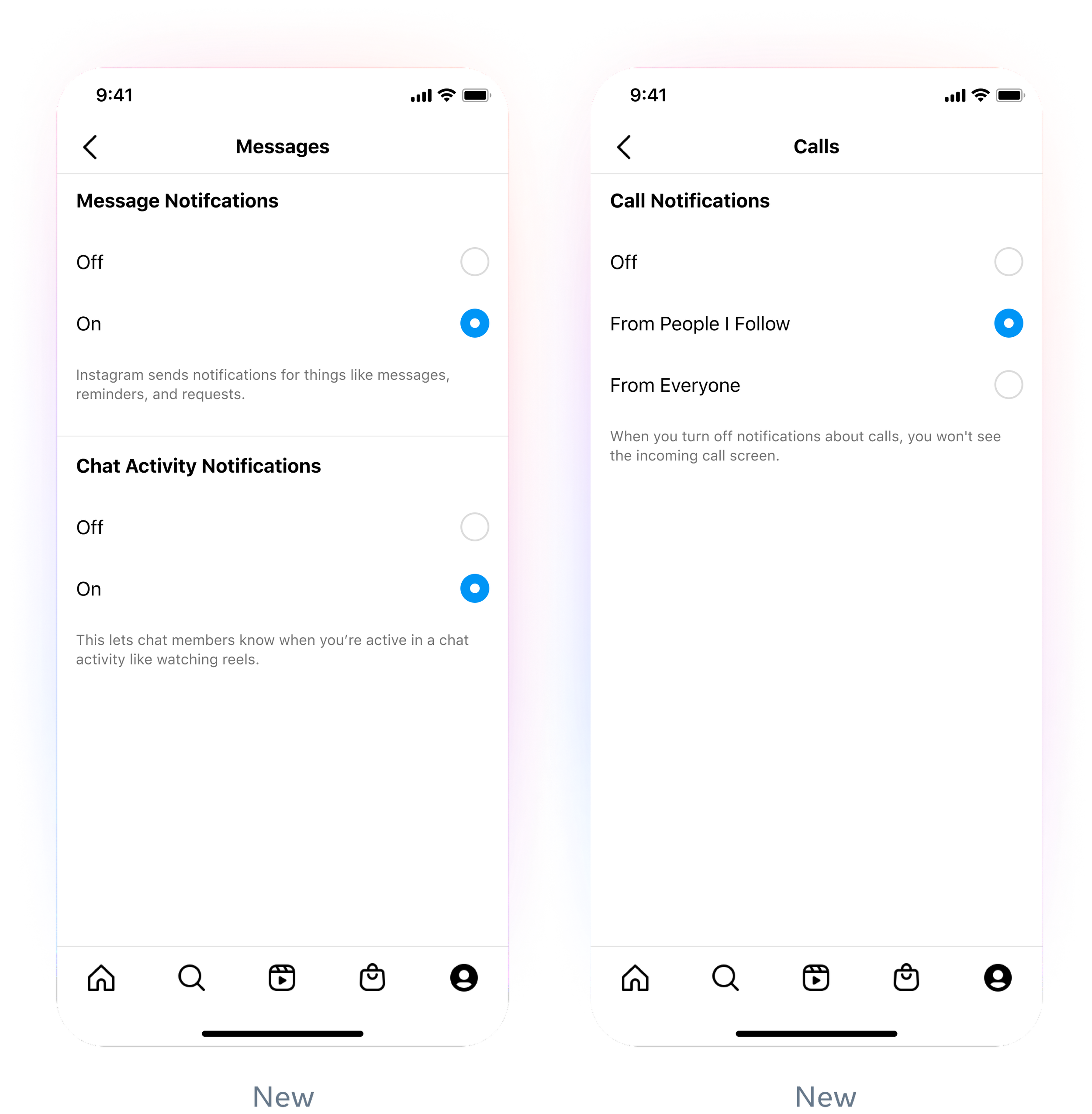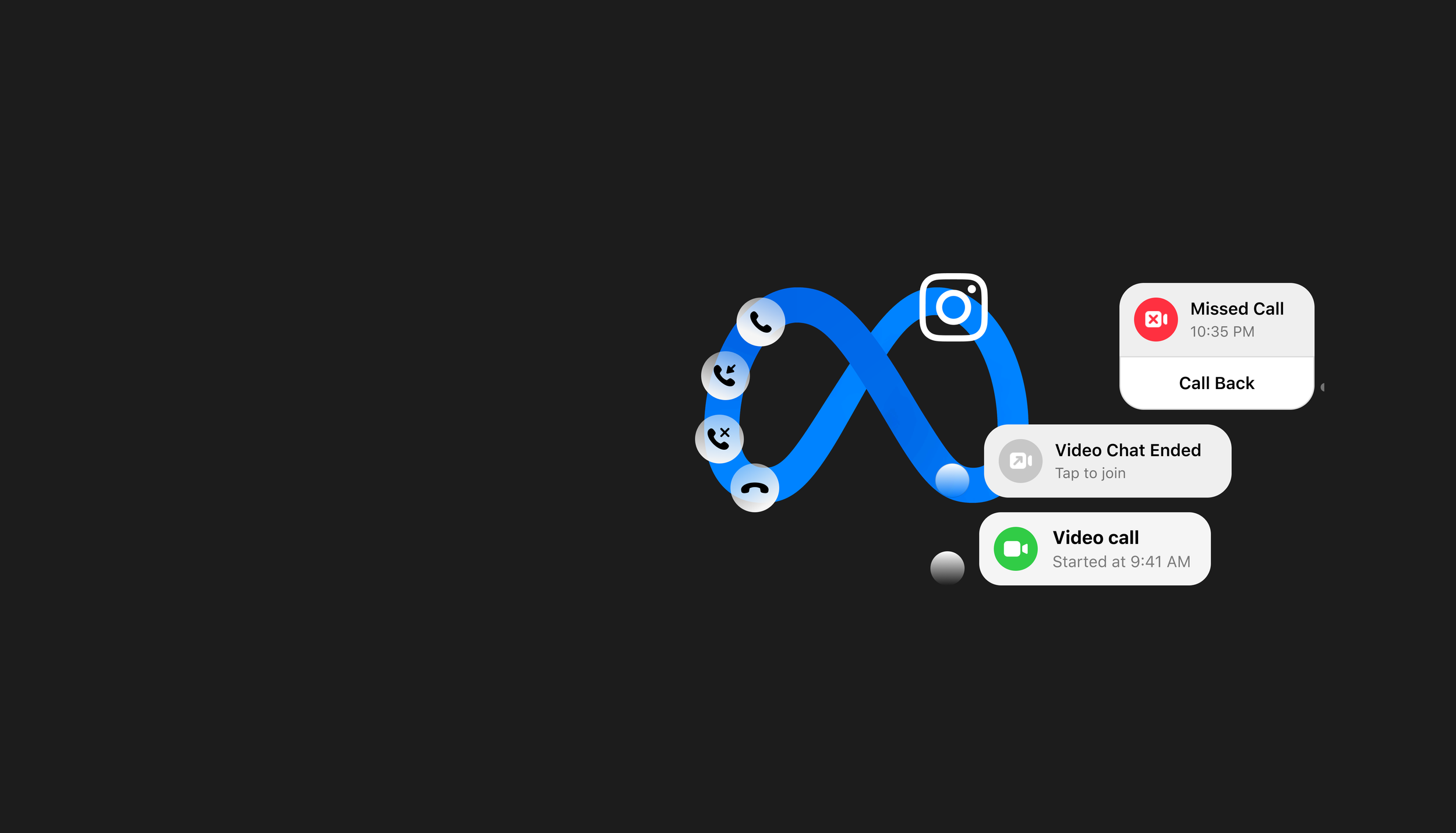
meta
tackling suboptimal calling experiences on instagram
summary
As part of Instagram’s goal to improve the quality of calling experience, I worked on identifying and tackling suboptimal video and audio calling experiences (SOCs) (minor frustrations in the product that add up to undermine the user experience). I collaborated with designers, product managers, and engineers to 1) bring users greater control over call notifications and 2) reduce the number of failed calls.
role
Product Design Intern
on Instagram Remote Presence
team
Product Manager, UX Researcher, Content Designer, Software Engineer, Data Scientist, Legal
timeline
May 2022- Aug 2022
results
Presented one feature and one conceptual design deck to design executives at Design Review
Drove strategy by presenting new feature recommendations to larger team, making several design changes that were in testing when I left.
Collaborated with the Messenger team to ensure design consistency of experiences between Instagram and Messenger.
Validated ideas through user research and presented results to stakeholders to gain alignment and prioritization.

background
People are missing calls due to silenced notifications, and a good chunk of that (4% of all initiated calls) is because people have their thread call notifications muted. This negatively impacts our product usage and user perception with missed calls. In addition, users have also expressed a need around customizing their notifications and want greater control over how they manage their notifications. Given the research and data, the overarching question was:
“How might we reimagine the notification experience so users have greater control over their notifications?”
Since we know that people are missing calls due to silenced notifications, there is an opportunity to give users greater control over their call notifications by allowing users to mute thread notifications for certain time durations. This will reduce the amount of missed calls, increase our end-to-end call connect rate and overall, boost user satisfaction and perception of product quality.
design solutions
Mute from thread
Users can tap the mute icon in a thread’s details page, select the type of notification they want to silence, and choose the time duration for which this action will be effective.
Mute from Inbox
Another entrypoint into the muting flow is by swiping (iOS) or long-pressing (Android) on a thread. The same muting experience would occur.
unmute banner
Reminds users to unmute an indefinitely muted thread.
Banner Shown:
24 hours after user mutes thread indefinitely and receives a missed call from thread
Only once
Not Shown:
If user mutes thread for set duration (eg. 1 hour, 24 hours)
If user dismisses banner
Android
The same experience exists on Android devices.

process
research
competitive analysis
I audited 4 different calling apps to understand how incoming call notifications/ settings are handled. Each app serves a unique purpose for calling, which means unique approaches to how they imagine calling notifications and controls.
competitive Audit
I then conducted a competitive audit of calling systems in the same 4 calling apps, analyzing how each system offers notification and setting controls, both in call and externally.
Specifically, I looked into how each calling app allows users to mute calls from thread conversations, and the level of granularity for the type of notifications available to mute.
User Experience Research Review
I partnered with user experience researchers and data scientists to look into past research reports to opportunity size and prioritize different suboptimal calling experiences to tackle. I learned that:
[problem]
8% of initiated calls fail due to silenced notifications, and 4% is because of a particular thread being muted. That’s 5 million calls a day.
People are missing calls.
Getting too many notifications has forced some to turn off notifications completely.
People need customized notifications.
Participants mentioned a need around receiving Instagram notifications from the people they actually care about.
People want greater control.
Users are open to having greater control over their privacy. They also expect to be able to enact control over who can call them.
Source: Internal UXR Reports

2. digging deeper + Synthesis
[hypothesis]
Offering time durations for muting thread notifications will result in fewer people muting notifications indefinitely.
This hypothesis came from understanding how other platforms like Discord and Messenger allow users to mute for different time durations. The goal is that implementing this feature will reduce missed calls, increase e2e connect rate, and increase user perception of product quality.
Current instagram experience
This is the current Instagram experience. You tap the bell icon in chat details as an entrypoint to the muting experience and see a bottom sheet with toggles. Because we don’t have accessible data for understanding how people mute in Instagram, we looked to Messenger, which already lets users mute thread notifications for certain time durations.
Current Facebook Messenger experience
This is the current Facebook Messenger experience. The entrypoint of the bell icon is similar, and you get to first choose what notification you want to mute, and second, for how long.
Facebook Messenger Data
Working with data scientists, I was able to pull relevant data to inform how I designed this feature on Instagram. We discovered that 86% of muters choose to mute both calls and messages, which seems to indicate that if people want to silence notifications, they want to silence everything. In addition, we were able to identify key time durations that users found the most valuable. Most users chose to mute indefinitely, choosing the option that says “Until I change it”, with 24 hours and 1 hour also being the next common choices.
Learning: Most users chose to mute both messages and calls in a thread. They also typically choose mute indefinitely.

3. Design Iterations and testing
Given all the research and data, I designed three muting options that varied in user effort needed and customization offered. I worked with my UX research partner to put these three options through user research studies to test our hypothesis. We wanted to understand qualitatively the reasons why people mute the way they do and the level of customization people prefer.
Option 1- With One Tap
This option mutes all notifications. Users are able to tap the bell icon and mute all notifications from this thread. A success toast is triggered upon tap.
option 2- With Time Limit
This option mutes all notifications. Users are able to choose three different time options from an action sheet. After tapping the bell icon, an action sheet is presented to users. They can pick to mute message and call notifications for 1 hour, 24 hours or until I change it, which are the options users found most valuable on Facebook Messenger. A success toast is triggered upon choosing a time period.
uXR Study
option 3- With Notification Selection & Time Limit
Users are able to mute certain types of notifications for a set time. After tapping the bell icon, a bottom sheet is presented to users. They can pick to mute messages, calls, mentions (if they are in a group thread), or all notifications, which then slides to a second bottom sheet that asked for the time duration of muting. A success toast is triggered upon choosing a time period.
Participants (8):
US Teens and Young Adults: ages 13-24
Uses Instagram direct daily
Uses Instagram calling on a weekly basis
Mixed household income, gender, ethnicity
Goal:
Understand if the following notification design concepts resonate with Instagram users and the why behind this.
There is a range of customization options that we can offer. Discover qualitatively the level of customization people prefer.
Results:
Users were split on whether muting should be whether muting should be one tap for everything or more customized with time options.
Out of 8 participants, 3 liked option 3 the best and 2 liked option 2. This may validate that users want more control over call notification duration.
Ultimately, while option 2 balanced user effort with customization, future project dependencies of adjacent teams (that required splitting out notifications into their respective categories) pushed my team to test and develop option 3.
other projects I worked on
Call Controls
Problem: Callers can enter the calling experience in cases where the call would not connect to the recipient.
4% of initiated calls fail because of unapproved threads.
5% of initiated calls fail Callability. Part of it is due to blocked relationships.
The experience: Call rings for 60 seconds, then falls to ‘No Answer’ screen. Callee does not get push notification.
Hypothesis: Stop users from entering failed calls to begin with. This will increase end to end connect rate on Instagram and improve user perception of safety and quality.
Solution: Remove call icons from unapproved threads. Show them once approved. Remove call icons from blocked threads.
notification Settings
Problem: From research, we know that users perceive calls to be distinct from messages and expect different controls. Our current notification settings page houses both messages and calls together.
Today, we have 8 sections on this page. It’s a bit to scroll through.
Hypothesis: Splitting out call and message notification settings will align with user understanding to make it easier to control notifications.
Solution: Simplify message settings by combining messages, message requests, message reminders, group requests notifications.
Simplify call settings by combining video chats and rooms, moving chat activity to message settings.
final thoughts
Goodbye party: Biggest thanks to all of 24th floor! <3
Manager and I at the Menlo office!
I’ve grown so much in my time at Meta! I was challenged to identify areas of improvement within a mature product, pitch those ideas, and work within a well-developed team and design system. Importantly, I’ve become a designer who can work effectively across multiple cross-functional and product teams to reach a common goal. My favorite takeaways, though, are things I’ve picked up in between 1:1’s, design crits, office hours, and reviews that remind me of why I design— and how important communication and storytelling are for ideas to come to life.
As I look back, I’m proud to say that I’ve left my mark on Instagram by working on a couple impactful SOCs. Thank you to all who have pushed me to keep improving!


